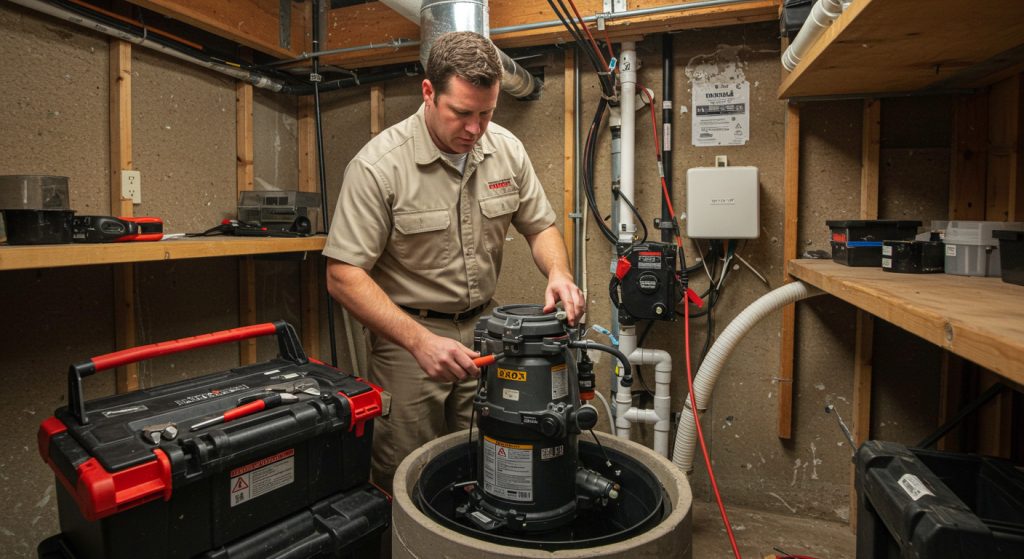Keep Your Basement Safe with Simple DIY Care
If you live in Willoughby, OH, you know how important a working sump pump is—especially during spring rains and snowmelt. While professional inspections are key, homeowners can and should perform regular sump pump maintenance to prevent sudden failure.

At Tom Schaefer Plumbing, Heating & Cooling, we recommend following this simple guide to keep your system working between professional service visits.
Safety First: Before You Begin
Always unplug the sump pump from its power source before touching any part of the unit. If your system includes a battery backup, disable it during cleaning and inspection to avoid accidental activation. Never handle wiring, float switches, or internal components if you suspect electrical damage—call a licensed professional immediately.
Step-by-Step DIY Sump Pump Maintenance
Remove Debris from the Pit
Check the sump basin for dirt, rocks, or other debris. Use gloves and a small bucket or shop vac to clear out the pit. Debris can clog the pump intake or jam the float switch.
Inspect and Clean the Pump
Carefully remove the pump from the pit and check it for signs of rust, corrosion, or worn parts. Wipe it down with a damp cloth. If your pump has a screen or intake grate, clean it thoroughly. If you notice heavy corrosion or hear unusual noise during operation, contact a professional.
Check the Float Switch
The float switch activates the pump when water levels rise. Gently lift and lower the float to ensure smooth movement. A stuck or obstructed switch is one of the most common causes of failure. Never tamper with wiring or internal adjustments—leave those to professionals.
Test the Pump with Water
Slowly pour a bucket of water into the sump pit. The float should rise and trigger the pump. Watch for smooth water evacuation. If the pump doesn’t turn on or fails to drain the water completely, stop the test and call a licensed technician.
Examine the Discharge Line
Inspect the exterior end of the discharge pipe. Make sure it’s not blocked by debris, ice, or vegetation. Confirm the water outlet is directed at least 10 feet from your foundation. Any damage, freezing, or backflow signs should be addressed professionally.
Plug It Back In
Once cleaning and testing are complete, reconnect the power and ensure the pump is ready for use. Never plug the pump back in if there is standing water near electrical connections—this creates a serious risk of electrical shock. If unsure, contact a licensed plumber or electrician.
Maintenance Frequency
Perform these DIY maintenance steps every 3 to 4 months, especially before and after the rainy season. Schedule a professional inspection at least once a year to evaluate electrical safety, backup power systems, and overall mechanical condition.
When to Call a Professional
While DIY checks are useful, call Tom Schaefer Plumbing, Heating & Cooling if you notice any of the following:
- Strange noises or excessive vibrations
- Repeated short cycling (turning on and off)
- No response during water test
- Electrical concerns, tripped breakers, or visible wiring damage
FAQs About DIY Sump Pump Maintenance
Can I use bleach or chemicals to clean the sump pit?
No. Use only mild soap and water. Harsh chemicals can damage components or affect groundwater drainage.
Is it okay to test the pump frequently?
Yes. Testing it with water every few months ensures it’s operational when you need it.
Should I install a battery backup system?
Yes. Battery backups keep your pump running during power outages and should be installed by a licensed professional to ensure reliability.
Did You Know?
Over 60% of sump pump failures happen due to lack of maintenance—and most are preventable with basic DIY care.
Have questions or need a professional checkup? Contact Tom Schaefer Plumbing, Heating & Cooling to schedule your annual sump pump inspection and keep your home protected.










